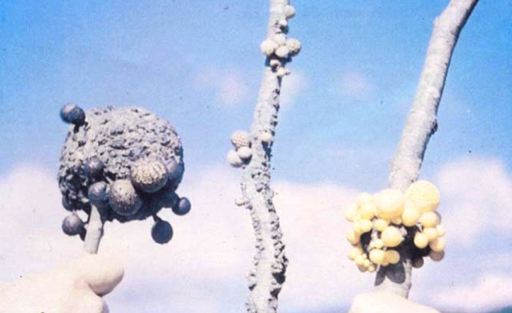PESTS AND DISEASES OF FORESTRY IN NEW ZEALAND
Cyttaria galls on silver beech
Scion is the leading provider of forest-related knowledge in New Zealand
Formerly known as the Forest Research Institute, Scion has been a leader in research relating to forest health for over 50 years. The Rotorua-based Crown Research Institute continues to provide science that will protect all forests from damage caused by insect pests, pathogens and weeds. The information presented below arises from these research activities.
Forest Pathology in New Zealand No. 9.
Based on P.D. Gadgil (1985)
Causal organisms
Cyttaria gunnii Berkeley, C. nigra Rawlings, C. pallida Rawlings

Fig. 1 - Fruiting bodies of Cyttaria gunnii , covering and obscuring the small gall on which they are borne.
The immature fruiting bodies are lighter in colour than the honeycombed, mature fruiting bodies.
Type of injury
Development of perennial galls on branches and stems leading to malformation and occasionally to death of branches.
Diagnostic features
The fungi produce galls on branches and stems of silver beech ( Nothofagus menziesii ); these galls are perennial and produce crops of fruiting bodies each spring (September -November).
The distinguishing features of the three species are as follows:
Cyttaria gunnii (Fig. 1, 2)
- Branch galls roughly spherical, rarely more than twice the diameter of the host branch, and usually occupying about two-thirds of its circumference.
- Stem galls usually in the form of encircling bands.
- Gall surface under the bark contorted and projected into sharp spines.
- Fawn to bright yellow fruiting bodies, pear-shaped, up to 2 cm in diameter.
Cyttaria nigra (Fig. 2)
- Galls roughly spherical, usually considerably more than twice the diameter of the host branch or stem. On larger trees, galls 1 m or more in diameter are common.
- Gall surface under the bark has bluntly rounded projections and a few, very short spines.
- Slack or black and gold fruiting bodies, pear-shaped with black incrustations, up to 2 cm in diameter.
Cyttaria pallida (Fig. 2)
- Branch and stern galls long and spindle-shaped, sometimes several feet long.
- Dirty white fruiting bodies, spherical, somewhat flattened, up to 1.5 cm in diameter.
Host
Nothofagus menziesii
Distribution
The fungi are present throughout New Zealand, wherever the host tree is found.
Disease development
Germinated spores invade the tissues of new shoots and produce chemical substances which cause proliferation of the host tissue and lead to gall formation. With C. gunnii and C. nigra the fungus travels only a short distance in the host, producing localised galls. With C. pallida, however, the fungus grows down the branch or stem and the gall increases steadily in length for many years.
Fruiting bodies arise from the spines produced in the wood of the host by the action of the fungus. These spines, consisting of fungal hyphae and woody tissue, project through the bark nearly to the exterior. Spores are discharged in visible clouds from ripe fruiting bodies.
The galls are perennial and keep growing as long as the host branch or stem is alive.

Fig. 2 - Left: Fruiting bodies of Cyttaria nigra . Note the large size of the gall in relation to the diameter of the branch.
Centre: Fruiting bodies of Cyttaria pallida produced on long, spindle-shaped galls.
Right: Fruiting bodies of Cyttaria gunnii .
Economic importance
Cyttaria galls are most often found on heavily branched trees growing either on the borders of clearings or in open stands. Girdling galls may lead to the death of upper parts of the branch or stem. Galls of C. pallida cause twisting of the branches, which often break in high winds.
The effect of Cyttaria spp. on timber production in managed N. menziesii stands has not been studied.
Control
No control measures are known.
Notes: Species of Cyttaria grow only on Nothofagus spp. and are also found in South America (6 species) and Australia (2 species). In South America, the galls are used for making ornaments and the fruiting bodies are eaten.
Bibliography
Gadgil, P.D. 1985: Cyttaria galls on silver beech. New Zealand Forest Service, Forest Pathology in New Zealand No. 9.
Rawlings, G. B. 1956: Australasian Cyttariaceae . Transactions of the Royal Society of New Zealand 84: 19-28.
Compiled: 1985: Revised 2010.
This information is intended for general interest only. It is not intended to be a substitute for specific specialist advice on any matter and should not be relied on for that purpose. Scion will not be liable for any direct, indirect, incidental, special, consequential or exemplary damages, loss of profits, or any other intangible losses that result from using the information provided on this site.
(Scion is the trading name of the New Zealand Forest Research Institute Limited.)

 Farm Forestry New Zealand
Farm Forestry New Zealand

